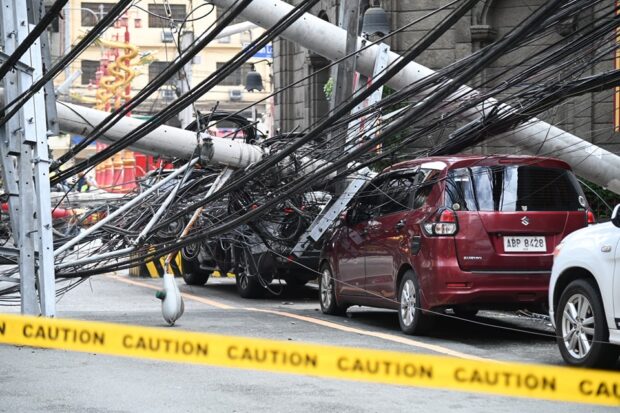
Screengrab from video: Radyo Inquirer / Richard Garcia
The sudden collapse of seven power pylons in Manila’s Binondo district on Thursday afternoon not only prompted calls for an investigation into the immediate cause.
It also drew attention to the increasing weight of cables that these concrete pylons are made to support, which may already be compromising public safety.
Interior Secretary Benhur Abalos ordered the Bureau of Fire Protection to look into the domino-effect incident that injured three people, damaged eight vehicles and cut off power to several homes and establishments in the busy commercial area.
One of the city’s congressmen said it was time to study whether the area—host since the Spanish colonial period of what is now considered the world’s oldest Chinatown— can be feasibly reworked for underground cabling.
Reinstallation
Based on security camera footage, the lower section of one of the pylons outside Binondo Church at the corner of Quintin Paredes and Ongpin streets suddenly broke around 1 p.m. on Thursday, dragging down the six other pylons.
The Manila Police District (MPD) said the collapse left three people—Joffer Dolatre, 32, a resident of Binondo; John Michael Tigoy, 21, of Caloocan City; and Beverly Balledo, 25, of Navotas City—with minor injuries.
The affected streets were closed to traffic until 7 p.m. and power supply to at least 15 nearby establishments had to be cut for safety reasons.
Binondo Church, also known as the Minor Basilica and National Shrine of San Lorenzo Ruiz, was forced to cancel its 5 p.m. Mass on Thursday due to the incident.
Regularly inspected
On Friday, Princess Abante, spokesperson for the city government, said all the fallen poles belonging to Manila Electric Co. (Meralco) had been replaced with new concrete pylons.
Authorities were looking at the heavy load of cables as the possible reason for the collapse. Strong winds were initially ruled out as the cause as there was no storm that afternoon.
Arnel Angeles, director of the Manila Disaster Risk Reduction Management Office, the old pylons apparently gave in under the weight of the cables.
Ariel Lucas, head of Meralco’s distribution services, said it was also possible that a truck snagged the cables and caused the collapse.
Eyewitnesses interviewed on TV, however, said there were no trucks passing at the time.
According to Abante, the city’s engineering and public works department had been regularly inspecting all power pylons in Manila. “Part of their regular operations (is) the bundling of wires and retirement of wooden and leaning posts” in coordination with Meralco, she said. Meralco’s Manila Sector team leader Joseph David said the company had reached out to the injured persons as well as to the affected residents and vehicle owners regarding compensation for the damage.
Inspect pylons
In a statement, Abalos directed local government units to inspect power pylons, construction sites, billboards and other similar installations that may collapse during heavy rains. For Manila Rep. Joel Chua, Thursday’s incident calls for a “long-term solution” to prevent such dangers from recurring.
“I will also ask engineers and economists to study the feasibility of laying the utility cables underground in some parts of Binondo and Quiapo, instead of keeping them hanging on posts,” Chua said in a statement.